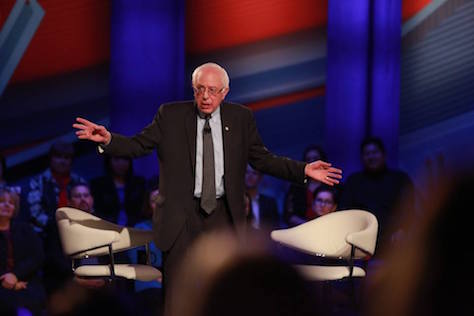
Earlier in January, I gamed out what I thought would be the more toughly fought of the 2016 primary fights — that on the Republican side. 
![]()
By and large, my analysis held up — Ted Cruz and Donald Trump will both live to fight another day and a third candidate (Marco Rubio) will now have fresh momentum in New Hampshire to consolidate ‘establishment lane’ supporters.
Polls, in the days leading up to the Iowa caucuses on the Democratic side, showed a very tight race between Vermont senator Bernie Sanders and former US secretary of state Hillary Clinton and, as of this post, she’s up by 49.9% to 49.6%.
It’s great news for Clinton, because the Sanders campaign always seemed best fit to states like Iowa (and New Hampshire, where Sanders is currently projected to win by a double-digit margin).
But 49.9% in a race for a former first lady, New York senator and the 2008 presidential runner-up? Losing by a nearly 4-to-1 margin among young voters, the future of the Democratic Party? Weak tea.
So Iowa is, essentially, a tie.
The most valuable lesson that we learned is that the 2016 election is not just a rerun of the 2008 election, a theory that’s become popular among some commentators.
Very broadly, in 2008, Obama crafted a coalition of three sets of voters: African Americans and Latinos, so-called ‘wine track’ white voters (typically higher income and professional) and the young, while Clinton attracted women and so-called ‘beer track’ white voters (typically lower income). Demographics were destiny, so much so that you could plausibly predict a primary’s winner in 2008 on the electorate demographics alone.
Last night showed that 2016 is scrambling those coalitions. Sanders is winning a dwindling contingent of ‘beer track’ voters (many of whom are trending Republican), a handful of ‘wine track’ voters and the young. Clinton is winning women, minorities and a plurality of ‘wine track voters.’ For example, Clinton leads among those who make over $100,000 in income, Sanders less than $50,000.
Each candidate in 2016 is winning around 50% of Obama’s 2008 supporters and around 50% of Clinton’s 2008 supporters:
That makes relatively ‘whiter’ states like Iowa and New Hampshire fertile ground for Sanders; it’s a different story in more diverse states like Nevada and South Carolina, to say nothing of California or New York or Florida.
So his post-New Hampshire challenge will be to win over more ‘wine-track’ white voters and minorities.
Many voters still think Sanders doesn’t have the right experience to be president. But he has decades of legislative experience building relationships in Congress and, perhaps most importantly, executive experience as Burlington’s mayor, where he governed as a pragmatic progressive, championing things like mixed-use housing, green space and bike paths — urban policies that seemed outlandish, perhaps, in the 1980s but are commonplace today. Sanders has left that record completely out of his campaign’s narrative.
Sanders has struggled to demonstrate his understanding, let alone commitment, to the priorities of the Black Lives Matter movement. But even in the second term of the first non-white US president, racial injustice remains stubbornly commonplace in American justice and economic systems, and Sanders must give racial inequities as prominent a role as income inequality if he wants to have any real chance at the nomination.
